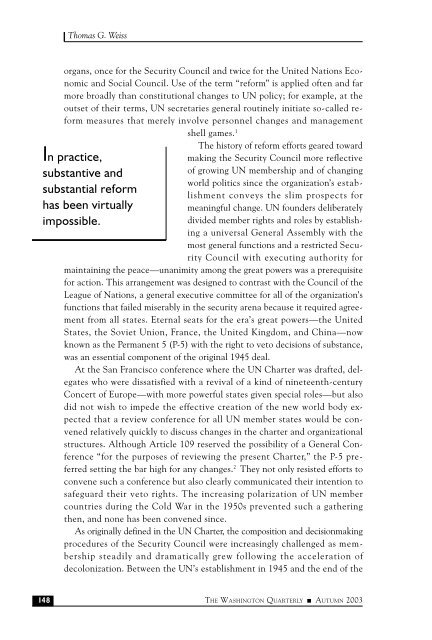The Illusion of UN Security Council Reform - United Nations ...
The Illusion of UN Security Council Reform - United Nations ...
The Illusion of UN Security Council Reform - United Nations ...
You also want an ePaper? Increase the reach of your titles
YUMPU automatically turns print PDFs into web optimized ePapers that Google loves.
148<br />
l Thomas G. Weiss<br />
organs, once for the <strong>Security</strong> <strong>Council</strong> and twice for the <strong>United</strong> <strong>Nations</strong> Economic<br />
and Social <strong>Council</strong>. Use <strong>of</strong> the term “reform” is applied <strong>of</strong>ten and far<br />
more broadly than constitutional changes to <strong>UN</strong> policy; for example, at the<br />
outset <strong>of</strong> their terms, <strong>UN</strong> secretaries general routinely initiate so-called reform<br />
measures that merely involve personnel changes and management<br />
shell games. 1<br />
<strong>The</strong> history <strong>of</strong> reform efforts geared toward<br />
making the <strong>Security</strong> <strong>Council</strong> more reflective<br />
<strong>of</strong> growing <strong>UN</strong> membership and <strong>of</strong> changing<br />
world politics since the organization’s establishment<br />
conveys the slim prospects for<br />
meaningful change. <strong>UN</strong> founders deliberately<br />
divided member rights and roles by establishing<br />
a universal General Assembly with the<br />
most general functions and a restricted <strong>Security</strong><br />
<strong>Council</strong> with executing authority for<br />
maintaining the peace—unanimity among the great powers was a prerequisite<br />
for action. This arrangement was designed to contrast with the <strong>Council</strong> <strong>of</strong> the<br />
League <strong>of</strong> <strong>Nations</strong>, a general executive committee for all <strong>of</strong> the organization’s<br />
functions that failed miserably in the security arena because it required agreement<br />
from all states. Eternal seats for the era’s great powers—the <strong>United</strong><br />
States, the Soviet Union, France, the <strong>United</strong> Kingdom, and China—now<br />
known as the Permanent 5 (P-5) with the right to veto decisions <strong>of</strong> substance,<br />
was an essential component <strong>of</strong> the original 1945 deal.<br />
At the San Francisco conference where the <strong>UN</strong> Charter was drafted, delegates<br />
who were dissatisfied with a revival <strong>of</strong> a kind <strong>of</strong> nineteenth-century<br />
Concert <strong>of</strong> Europe—with more powerful states given special roles—but also<br />
did not wish to impede the effective creation <strong>of</strong> the new world body expected<br />
that a review conference for all <strong>UN</strong> member states would be convened<br />
relatively quickly to discuss changes in the charter and organizational<br />
structures. Although Article 109 reserved the possibility <strong>of</strong> a General Conference<br />
“for the purposes <strong>of</strong> reviewing the present Charter,” the P-5 preferred<br />
setting the bar high for any changes. 2 <strong>The</strong>y not only resisted efforts to<br />
convene such a conference but also clearly communicated their intention to<br />
safeguard their veto rights. <strong>The</strong> increasing polarization <strong>of</strong> <strong>UN</strong> member<br />
countries during the Cold War in the 1950s prevented such a gathering<br />
then, and none has been convened since.<br />
As originally defined in the <strong>UN</strong> Charter, the composition and decisionmaking<br />
procedures <strong>of</strong> the <strong>Security</strong> <strong>Council</strong> were increasingly challenged as membership<br />
steadily and dramatically grew following the acceleration <strong>of</strong><br />
decolonization. Between the <strong>UN</strong>’s establishment in 1945 and the end <strong>of</strong> the<br />
In practice,<br />
substantive and<br />
substantial reform<br />
has been virtually<br />
impossible.<br />
THE WASHINGTON QUARTERLY ■ AUTUMN 2003


